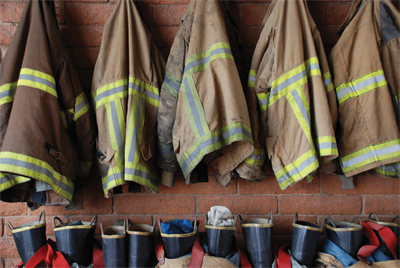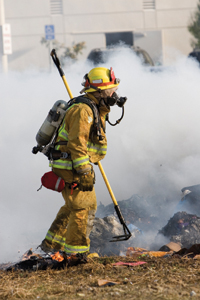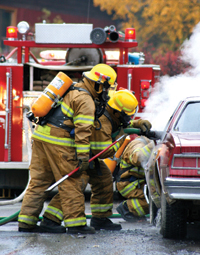
Features
Training
Strengths and weaknesses
In Canada, organizations and their supervisors can be held criminally responsible under Bill C-45 for injury or death caused by reckless disregard for an employee’s safety. What is reckless disregard? It is not limited to the actions at the emergency scene but can include events leading up to the incident.
November 6, 2009
By Craig Richardson and Bob Simpson
In Canada, organizations and their supervisors can be held criminally responsible under Bill C-45 for injury or death caused by reckless disregard for an employee’s safety. What is reckless disregard? It is not limited to the actions at the emergency scene but can include events leading up to the incident.
Imagine you are in a courtroom, on the stand. The prosecutor is asking you questions about an incident to which you responded and during which a firefighter was seriously injured. The prosecutor’s questions about your skills are predictable. Unfortunately, so are your answers (along with those of most emergency responders).
 |
| Imagine that every job in your fire department has a set of competencies (skills, knowledge and attitudes) and that a menu of competencies is available to you and every other person in your department. This menu clearly defines the competencies required for promotion to the next position all the way up to fire chief.
|
Q: What training did you receive?
A: I was NFPA 1001 certified at level II in 1996, which included the skill in question.
Q: When was the last time you had any training?
A: My fire department’s training records have been supplied to the court and show that I was involved with drills at least three times per year.
Q: When was the last time you were tested in the specific skill?
A: In 1995 at recruit school.
Q: So the last time you had anyone examine your skills was more than 10 years ago? How does that prove that you are competent?
A: Yes, well, but, um, I am certified at NFPA 1001 level II.
See where this is going?
It is no longer considered bad taste to sue fire departments and name individual responders in the suits.
We attend a school or training academy, obtain a passing grade and then, on the stand, the lawyer asks:
Q: What is the passing grade for this skill?
A: Seventy or 75 per cent.
Q: I see. So, what per cent of the liability for this incident falls inside the 25 to 30 per cent that you failed?
A: ?????
 |
|
| Canada appears to lead the way in this new field of competency validation, in which skills are validated throughout a person’s career and a record or lifelong manuscript is kept for the purpose of advancement.
|
There are really three sides to the discussion about validating competencies: reducing liability; ensuring we are capable of performing the skills required to do our jobs; and developing the confidence that comes from being capable. The courtroom scenario above illustrates the potential risks of not having our skills routinely tested and recorded.
This is particularly true for officers in charge of operations during which responders are injured. Recent events in Canada and the U.S. during which supervisors and entire organizations have been held responsible for the deaths of emergency responders are indicative of the legal protection we may require from competency validation. The advantage for responders whose skills are routinely validated is that they become better at their jobs and safer while performing them. In addition, this regular competency validation can lead to advancement or provide other career options should some firefighters become unable to perform their current jobs.
Here’s another story. Imagine you were a boy scout growing up. As part of your time spent in Scouts, you earned your knot-tying badge, which included several of the knots used in the fire service. Now imagine that your ability to tie these knots, or your skill competency, was validated and recorded by your Scout leader and that this was done every two to three years. Now you are in your early 20s and you want to go to fire school and get your NFPA 1001 training. You have a personal history of validated competencies (a transcript of your life skills) that has been with you since primary school and it also contains your validated competencies, including knot tying. Why should you need to complete the knot-tying portion of NFPA 1001 training if you have been validated in this skill and maintained that validation regularly?
Under this competency validation scenario, each competency – or skill – has a life span during which it would require re-validation. Validation is simply the performance of the competency, or skill, witnessed by a certified validator, instructor, examiner or superior. Validation need not be a formal testing session but rather can be witnessed use of the skill – a fire officer could validate, or re-validate the competency of one of his firefighters in ground-ladder deploys by acknowledging that this firefighter placed and used a ground ladder at a fire scene or during a regular drill session. If there is no opportunity for the skill to become validated during the normal course of work, a special session may be scheduled to validate particular competencies.
Fast forward to the courtroom after a competency validation program has been implemented. Now the answers are based on validation of competency by a recruit school instructor and, subsequently, by your fire officer (who has been validated as competent in the assessment of employees, subordinates and trainees). Does this sound more appealing as you face those tough questions on the stand?
Imagine that every job in your fire department has a set of competencies (skills, knowledge and attitudes) and that a menu of competencies is available to you and every other person in your department. This menu clearly defines the competencies required for promotion to the next position all the way up to fire chief. You, as an employee, could figure out which skills or competencies you have and which ones you need to advance within the department, then work toward learning those skills and being validated by a certified validator of those skills. Of course, you would still need to apply for and win any promotions but that competency set becomes your promotional plan and the employer’s method of measuring your ability to perform the job for which you have applied.

|
|
| With pressure on supervisors to be accountable for the competency of their employees, validation of competency has the power to limit risk.
|
Now, take that a step further and lay the competencies of a firefighter, level II, on top of the competencies of other careers such as a carpenter or police officer. The competencies for these other careers are defined and it is therefore simple to determine which competencies or skills you need to become qualified for these other jobs.
Imagine further that your lifelong transcript of validated competencies travels with you to the registrar’s office at a university. The university lays the matrix of competencies for which you have been validated (and which you have maintained) on top of the competencies defined in the degree or diploma program in which you wish to enrol. It sounds reasonable that you would need only to become validated as competent in the skills that you are missing to reach that academic level.
This may seem like a dream world, or like a nightmare for records management people, but there are agencies that specialize in competency validation, including the Canadian company World ICU (www.worldicu.com ).
Canada appears to lead the way in this new field. World ICU, which introduced this concept in the Alberta oil fields, has already defined 6,500 competencies for careers in myriad industries. The company can track your lifelong transcript of competencies and produce records for the purpose of advancement in career or education, or for the purpose of litigation.
How does it work? A job profile (once called a job description) is broken up into competencies (knowledge, skills and attitude are described in competency speak). Each of the competencies is valued and given a time continuum for use or retraining. The competencies are stored on the WICU server that administrators and candidates can access from anywhere, at any time. The candidate is asked to do a self test and then a certified validator signs off to agree that the candidate is competent in certain skills. Credibility hinges on the system used to create the validators.
Forms of competency evaluation have always been used by the fire service, with locally developed training, check sheets and evaluators. What has been missing is the layer of accountability when it becomes important to respond to and meet a prescribed standard imposed by outside agencies, government, non-government agencies and in litigious situations. An independent and unbiased system that manages competencies needed to achieve specific career goals is the path to resolving most of the accompanying issues.
The pressure to be competent and to ensure competency has been taken to a new level.
BCERMS (BC), EMA (Alberta), NIMS (U.S.) and NFPA all establish management standards that all first responders must meet. Unfortunately, attendance at courses and schools alone fails to prove competency. And success that lawyers and official inquiries are having against responders and their departments is a red flag for all managers and supervisors. Indeed, there have been cases in Kimberly, B.C., Yellowknife and New York in which competency or lack thereof has resulted in departments and chief officers being found liable for injuries to first responders.
With increasing pressure on supervisors at all levels to be accountable for the competency of their employees, validation of competency has the power to limit our risk, make us better, safer and help us plan our careers in a way that is not typical in the reactionary culture of the fire service.
When each of the competencies in a career path is clearly defined, and the training needed is practical, employees can take control of their careers. Competency gives confidence, accredits life experience and guides learners in the decisions necessary for living to their
highest potential.
For more information on competency validation, please contact Bob Simpson or Craig Richardson at the e-mail addresses below.
Bob Simpson is Deputy Chief of Operations for Nanaimo Fire Rescue on Vancouver Island in B.C. Bob has 33 years of service with Calgary Fire Department as district chief where he introduced the concept of competency validation. E-mail: bob.simpson@nanaimo.ca.
Craig Richardson is the international director for the ISFSI and deputy chief of support and administration for Nanaimo Fire Rescue in B.C. He is a fire service educator delivering programs throughout Canada and internationally, and holds a master’s degree in leadership. E-mail: craig.richardson@nanaimo.ca
Print this page